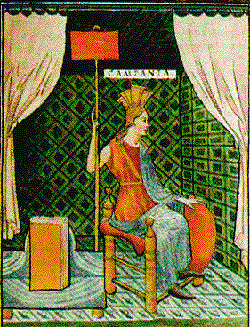 Contents -
Previous Article -
Next Article
Contents -
Previous Article -
Next Article
The Romans also needed to keep track of the ever growing number of imperial posts and the magistrates who filled them. NOTITIA DIGNITATVM, or the Registry of Important Civil and Military Offices, was compiled to list these magistracies, giving pictures of the symbols of rank and office. If the magistrate’s responsibility was for a specific geographic area, a symbolic picture representing the region was shown. It was a beautifully illustrated book and provided much information that is of value to historians today. The illustrations presented here are from a Fifteenth Century copy of a manuscript now in the posession of the Bodleian Museum at Oxford University. This 1436 copy is itself a copy of a manuscript made during the reign of Charlemagne that was a copy of an original, both of which are now lost. The original was believed to be a very beautifully turned out manuscript produced for Flavius Stilicho's own personal use during the late Fourth and early Fifth Centuries. Though the clothing of the figures is definitely drawn in a much later medieval style, historians are fairly sure that the monks who copied the manuscripts rendered the official insignia, symbols of office, shield decorations and other symbolic images quite accurately. Notice as you browse the images the great importance the Romans placed on the craft of writing. The ink stands, books, codicils, and lampstands figure prominently in the symbols of office. The Romans knew, as we also know today, that command of written language gave a person a great deal of power in society. By the same token, the symbols of office and power were made to convey a message about the office and responsibilities they represented to people of many tongues throughout the empire who had no command of the official Latin or Greek used in the praefecture where they lived.
Some of the most exquisite art about the fascinating period of history beginning with the death of Constantine and extending through the fall in the West and culminating with the Byzantine Reconquest are to be found on the pages of this lovely manuscript, prepared on vellum and richly bound. To view some of these panels reproduced in modern print please see the following resources:
Go to next article:
Go back to previous article: